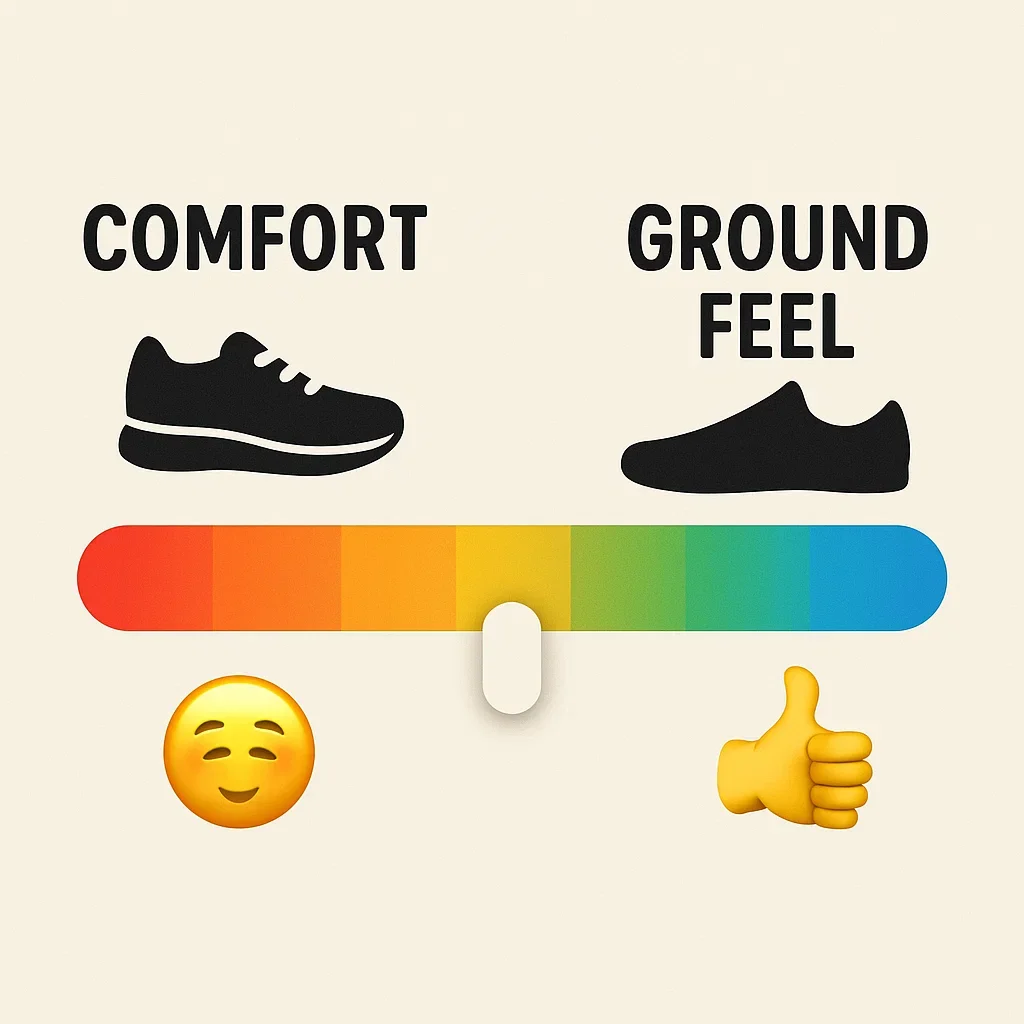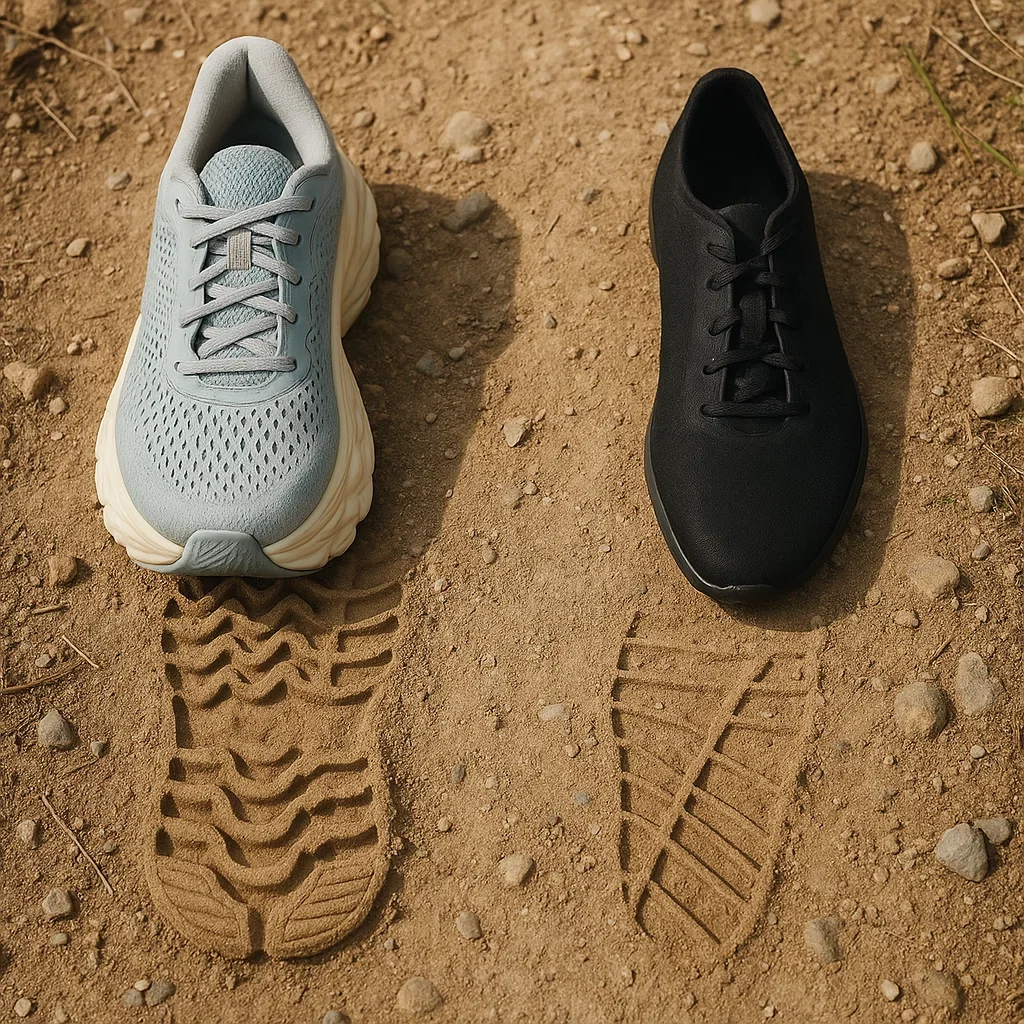Cushioned or minimal shoes for a 100K ultra marathon—which is truly better?
Welcome to the most detailed, unbiased, and user-focused comparison on the web. Comfort, speed, injury prevention, and terrain—let’s break it all down, so you finish stronger and happier!
- Cushion: Maximum shock absorption, plush comfort, fatigue delay. But sometimes—“dead legs,” less ground feel, unstable on technical ground.
- Minimal: Lighter, more “connected” stride, foot muscles work harder, better proprioception. But—risk of bruising, fatigue, pain after 60K+, especially on rocky or rough trails.
- Decision factor: Your body weight, injury history, terrain, and finish time goal all matter. The “best” shoe depends on you!
🏷️ Cushion vs Minimal Shoes – 100K Ultra Comparison Table
| Feature | Cushioned Shoe | Minimal Shoe |
|---|---|---|
| Weight | 250–350g | 160–240g |
| Cushion Level | Max/Plush | Low/Bare |
| Energy Return | High, but more “squish” | Direct, “springy” |
| Fatigue Resistance | Good (esp. 60km+) | Requires adaptation, less forgiving |
| Ground Feel | Low, muted | Excellent, “barefoot-like” |
| Protection (rocks/roots) | High | Low–moderate |
| Risk: Blisters | Possible if too soft/wide | Higher if no adaptation |
| Risk: Muscle Fatigue | Lower for most runners | Higher after 60K, unless well-trained |
| Best For | Heavier, injury-prone, comfort-seekers | Experienced, light, natural runners |
🧭 Decision Flowchart: Your Path to 100K Shoe Success
- Body Weight: Over 75kg? Try cushioned first. Under 65kg, experienced? Minimal could work.
- Foot/Joint Injury History: Yes? Go cushioned—protects knees, plantar, shins.
- Weekly Mileage: Under 50km? Be careful with minimal; adapt over months first.
- Race Terrain: Lots of rocks, long descents? Cushion wins. Smooth, dry, or rolling? Minimal can shine.
- Race Goal: Sub-14h? Both can work. Over 16h? Cushion is safer.
- Blister or pain-prone? More cushion and better fit reduce risk.
- Training: Can you do 50km in minimal shoes pain-free? If not, stay cushioned.
🏃♂️ Runner Stories: 100K—What Really Worked?
– Sarah, mountain ultra finisher
– Ethan, flat trail specialist
– Jin, 100K multi-finisher
- Are your feet sensitive to rocks and roots after 50km?
- Do you recover quickly from long runs, or need days off?
- Is your goal finish time under 14h or just to finish?
- Do you weigh under or over 70kg?
- Do you like to “feel” the ground or prefer cloud-like comfort?
Mostly “B” = Try minimal or hybrid.
Mixed? Test both on your longest training runs!
- Test both types on at least 30km runs—never experiment on race day.
- Rotate shoes if possible, especially if prone to fatigue in one style.
- Check for blisters and pressure points after every long training run.
- Try different insoles—some minimal shoes can “upgrade” with thin, cushioned inserts.
- Plan for late-race swelling: Pick a shoe that allows a little extra toe room.
- Bring backup socks, tape, and blister kits—comfort isn’t just about the shoe.
🔗 Explore More 100K Ultra Shoe Guides

❓ Advanced FAQ: Cushion vs Minimal Shoes for 100K Ultra Marathons
👟 Which is more popular in 100K races: cushion or minimal?
💡 Can you switch from cushion to minimal shoes right before race day?
🦶 How do I avoid blisters in both types?
🔄 Do minimal shoes last longer than cushioned?
⏱️ Should I bring two types to my 100K?
🧼 Care & Durability: Make Your Choice Last 100K (and Beyond)
- Alternate pairs in training: Don’t overuse one shoe—foam recovers better with rest.
- Dry thoroughly after every wet run: Remove insoles, stuff with paper, air dry—never direct heat.
- Monitor wear: Minimal shoes—look for outsole holes. Cushioned shoes—watch for “dead” midsoles and upper breakdown.
- Rotate socks and insoles for comfort and freshness.
- Patch rips and reinforce lace holes early.
- Keep a shoe log: Note which model you used, conditions, and how feet felt after each long run or race.
🏆 Pro Tips & Pitfalls: Cushion vs Minimal in the Real 100K World
- Tip: Use a mix of both during training to strengthen feet and avoid overuse injuries.
- Tip: Prioritize fit—test with different socks, during long and short efforts.
- Mistake: Chasing trends or copying elites. Your feet, your history, your race—customize!
- Mistake: Waiting for shoe “miracles” on race day—test everything well in advance.
- Bonus: In minimal shoes, do specific foot strengthening drills to reduce injury risk.
📚 Further Reading & Related Guides
Share This Guide!
Final Thoughts
There is no one-size-fits-all for 100K ultras: some runners thrive in clouds, others in “barefoot” ground feel. The only true test is long training miles—know your needs, adapt gradually, and prioritize comfort above trends. Run smart, finish happy, and see you on the trails!
🏅 Case Study: Two 100K Runners—One Cushioned, One Minimal
- Chose max cushion (Brooks Caldera 7).
- Training: 70km/week, never adapted to minimal shoes.
- Result: Finished strong, legs fresh after 90K, but noticed some instability on rocky descents.
- Takeaway: For heavy mileage and injury prevention, plush worked—but required extra focus on footing.
- Chose minimalist (Altra Superior).
- Training: Multi-year adaptation to zero-drop and thin shoes.
- Result: Fast on smooth sections, handled technical terrain well, but suffered calf cramps after 60K and sore arches by the finish.
- Takeaway: Great ground feel and agility, but only after serious gradual training. Muscle fatigue is a risk for unprepared runners.
🦶 Transition Tips: Go Minimal or Max Cushion Without Injuries
- Minimal Transition: Start with 1–2km runs, increase by 10% per week, add calf/foot strength work, use for speed sessions before long runs.
- Max Cushion Transition: Alternate with your regular shoes; monitor for balance/ankle stability issues; strengthen hips and ankles.
- Never “race in new shoes” for a 100K: Do at least 3 long runs (over 30km) in your race model.
- Track soreness: If you feel new pain in tendons, back off and slow the transition.
- Blister prevention: Tape known hotspots and use tried-and-tested socks for your chosen shoe type.
- Bonus: For minimal shoes, try a foot massage ball or toe spacers post-run to promote recovery and foot health.
🧬 Science Spotlight: Cushioning, Fatigue & Running Efficiency in 100K Ultras
- Research shows max cushion reduces peak impact forces, lowering injury risk in longer races, but may slightly reduce running economy for short, fast efforts.
- Minimal shoes promote higher cadence, lighter steps, and better proprioception, but require well-adapted muscles and tendons for ultras.
- Blending both types in training may optimize neuromuscular coordination and resilience, per several recent ultra studies.
- Biomechanics experts suggest picking the softest shoe that still feels “stable” and “natural”—test different options on mixed terrain.

About the Author
Lost Pace is an ultramarathon runner, shoe-tester and the founder of umit.net. Based year-round in Türkiye’s rugged Kaçkar Mountains, he has logged 10,000 + km of technical trail running and completed multiple 50 K–100 K ultras.
Blending mountain grit with data, Lost analyses power (CP 300 W), HRV and nutrition to craft evidence-backed training plans. He has co-written 260 + long-form guides on footwear science, recovery and endurance nutrition, and is a regular beta-tester of AI-driven coaching tools.
When he isn’t chasing PRs or testing midsoles, you’ll find him sharing peer-reviewed research in plain English to help runners train smarter, stay healthier and finish stronger.
Ultrarunner · Data geek · Vegan athlete

